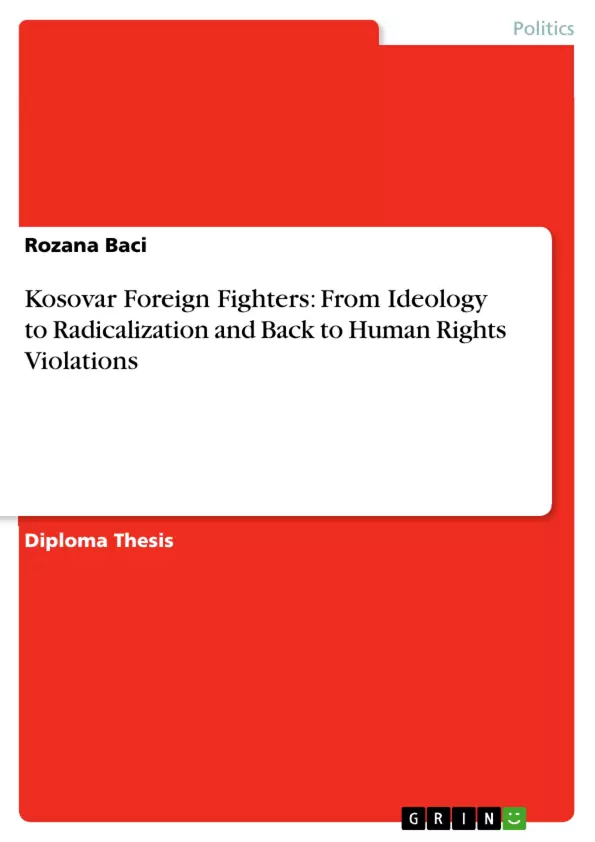The Independence was followed by a new shift in Albanian Kosovar's ideology. Once the national agenda had been achieved, the created sociopolitical gap was rapidly filled with a new religious ideology. Kosovar foreign fighters became a hot topic in fighting back the radicalization in Kosovo. Many citizens were arrested and brought before the Courts on suspicions related to terrorism. These prosecutions in fighting back foreign fighters brought distortions and violations of the foreign fighters' human rights.
The cases analyzed in this study do speak about the violation of the presumption of innocence, the right to a fair and other procedural rights violations. The overall situation on the issue of fighting back the Kosovar foreign fighters and extremist radicalization within Kosovo speaks of a lack of competencies by the Kosovar authorities. No matter what an individual is accused of, the presumption of innocence and the right to a fair trial should always prevail. It is up to the Kosovar authorities in the first place to show the good practice that such fundamental principles and rights are not only envisaged but embedded in daily proceedings.
Inhaltsverzeichnis (Table of Contents)
- Abstract
- Abbreviations
- Introduction
- Fighting into the Holy Land for the Holy War: Kosovar Foreign Fighters
- Defining Foreign Fighters and Kosovar Foreign Fighters
- Albanian Identity and Ideology
- From an Autonomous Province to a New State
- The Republic of Kosovo
- Framework Legislation
- International Framework
- Internal Framework
- Same Old Story?
- Kosovar Foreign Fighters and Human Rights Violations
- A Ghost Terrorist Organization
- The "ISIS-at" Case
- Ardian Mehmeti Case
- Conclusion
- Bibliography
- Appendix 1
Zielsetzung und Themenschwerpunkte (Objectives and Key Themes)
This master's thesis explores the issue of Kosovar foreign fighters and the associated human rights violations. The thesis examines the ideological and political contexts that contributed to the radicalization of these individuals, analyzing the legal frameworks both within Kosovo and internationally, and delves into specific case studies to highlight the violations of human rights during the prosecution of these fighters. The goal is to shed light on the complexities of fighting extremist radicalization in Kosovo and to emphasize the importance of upholding fundamental legal principles, such as the presumption of innocence and the right to a fair trial, in the process.
- The evolution of Albanian identity and ideology in Kosovo, particularly in the context of the country's independence and the rise of religious extremism.
- The legal framework for combating terrorism in Kosovo, including both international and domestic legislation.
- The specific human rights violations faced by Kosovar foreign fighters during their arrest, detention, and prosecution.
- The challenges and complexities of addressing extremist radicalization in Kosovo, including the lack of institutional capacity and the need for greater awareness of human rights.
- The importance of upholding fundamental legal principles, such as the presumption of innocence and the right to a fair trial, even in the context of fighting terrorism.
Zusammenfassung der Kapitel (Chapter Summaries)
The introduction provides an overview of the historical context, focusing on Kosovo's independence, the impact of the 9/11 terrorist attacks, and the subsequent rise of foreign fighters in Syria and Iraq. It highlights the significance of the issue in Kosovo and the challenges faced by the country in addressing this threat.
Chapter 1 delves into the concept of foreign fighters, focusing specifically on the motivations and ideology behind Kosovar foreign fighters. It analyzes the evolution of Albanian identity and ideology in Kosovo, exploring how the country's independence and the political vacuum it created contributed to the rise of religious extremism.
Chapter 2 examines the legal framework for combating terrorism in Kosovo, both at the international and domestic levels. It discusses relevant treaties and conventions, as well as Kosovo's domestic legislation and its implementation.
Chapter 3 focuses on the specific human rights violations faced by Kosovar foreign fighters during their arrest, detention, and prosecution. It examines the challenges of ensuring a fair trial and the impact of the "ISIS-at" and Ardian Mehmeti cases on the overall human rights landscape.
Schlüsselwörter (Keywords)
This study explores the complex interplay of ideology, radicalization, and human rights violations within the context of Kosovar foreign fighters. Key topics include Albanian identity, religious extremism, terrorism, human rights, the presumption of innocence, the right to a fair trial, and the challenges of fighting extremist radicalization in Kosovo.
- Citation du texte
- Rozana Baci (Auteur), 2016, Kosovar Foreign Fighters: From Ideology to Radicalization and Back to Human Rights Violations, Munich, GRIN Verlag, https://www.grin.com/document/353839



